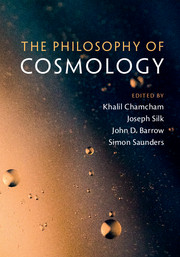Book contents
- Frontmatter
- Contents
- List of Contributors
- Preface
- Acknowledgments
- Part I Issues in the Philosophy of Cosmology
- Part II Structures in the Universe and the Structure of Modern Cosmology
- Part III Foundations of Cosmology: Gravity and the Quantum
- 9 The Observer Strikes Back
- 10 Testing Inflation
- 11 Why Boltzmann Brains do not Fluctuate into Existence from the de Sitter Vacuum
- 12 Holographic Inflation Revised
- 13 Progress and Gravity: Overcoming Divisions Between General Relativity and Particle Physics and Between Physics and HPS
- Part IV Quantum Foundations and Quantum Gravity
- Part V Methodological and Philosophical Issues
- Index
- References
13 - Progress and Gravity: Overcoming Divisions Between General Relativity and Particle Physics and Between Physics and HPS
from Part III - Foundations of Cosmology: Gravity and the Quantum
Published online by Cambridge University Press: 18 April 2017
- Frontmatter
- Contents
- List of Contributors
- Preface
- Acknowledgments
- Part I Issues in the Philosophy of Cosmology
- Part II Structures in the Universe and the Structure of Modern Cosmology
- Part III Foundations of Cosmology: Gravity and the Quantum
- 9 The Observer Strikes Back
- 10 Testing Inflation
- 11 Why Boltzmann Brains do not Fluctuate into Existence from the de Sitter Vacuum
- 12 Holographic Inflation Revised
- 13 Progress and Gravity: Overcoming Divisions Between General Relativity and Particle Physics and Between Physics and HPS
- Part IV Quantum Foundations and Quantum Gravity
- Part V Methodological and Philosophical Issues
- Index
- References
Summary
Introduction: Science and the Philosophy of Science
The ancient “problem of the criterion” is a chicken-or-the-egg problem regarding knowledge and criteria for knowledge, a problem that arises more specifically in relation to science and the philosophy of science. How does one identify reliable knowledge without a reliable method in hand? But how does one identify a reliable method without reliable examples of knowledge in hand? Three possible responses to this problem were entertained by Roderick Chisholm: one can be a skeptic, or identify a reliable method(s) (“methodism”), or identify reliable particular cases of knowledge (“particularism”) (Chisholm, 1973). But why should the best resources be all of the same type? Might not some methods and some particular cases be far more secure than all other methods and all other particular cases? Must anything be completely certain anyway? Why not mix and match, letting putative examples and methods tug at each other until one reaches (a personal?) reflective equilibrium?
This problem arises for knowledge and epistemology, more specifically for science and the philosophy of science, and somewhere in between, for inductive inference. Reflective equilibrium is Nelson Goodman's method for induction (as expressed in John Rawls's terminology). One need not agree with Goodman about deduction or take his treatment of induction to be both necessary and sufficient to benefit from it. He writes:
A rule is amended if it yields an inference we are unwilling to accept; an inference is rejected if it violates a rule we are unwilling to amend. The process of justification is the delicate one of making mutual adjustments between rules and accepted inferences; and in the agreement achieved lies the only justification needed for either.
All this applies equally well to induction. An inductive inference, too, is justified by conformity to general rules, and a general rule by conformity to accepted inductive inferences. Predictions are justified if they conform to valid canons of induction; and the canons are valid if they accurately codify accepted inductive practice. (Goodman, 1983, p. 64, emphasis in the original) Most scientists and (more surprisingly) even many philosophers do not take Hume's problem of induction very seriously, although philosophers talk about it a lot. As Colin Howson notes, philosophers often declare it to be insoluble and then proceed as though it were solved (Howson, 2000).
- Type
- Chapter
- Information
- The Philosophy of Cosmology , pp. 263 - 282Publisher: Cambridge University PressPrint publication year: 2017
References
- 4
- Cited by



